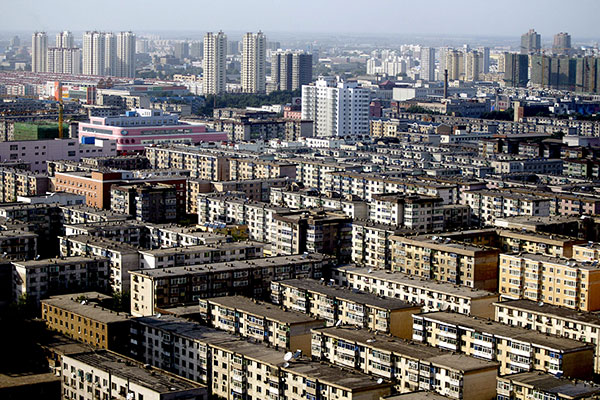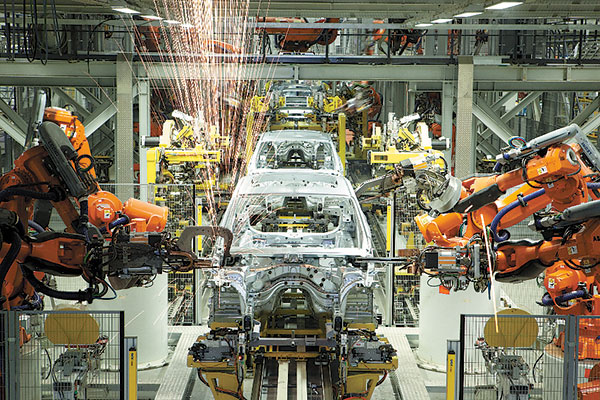
Shenyang’s Tiexi shows off a new look. It was the backbone of the nation’s industry until 1990s when all the machinery there became outdated.[Photo/China Daily]
One-time manufacturing king-turned rust belt capital has regained its regal attire
A superhero, a witch and a giant apple walk into a bar. It is Halloween in the city of Shenyang, and the trio of costumed revelers joins a table of strangely attired friends knocking back beers and cocktails.
Behind the makeup and the outfits the group of young men and women are for the most part professionals from Australia, Germany, Russia and the United States.
That they are here at all is telling.
As recently as 10 years ago, there were few foreigners in Shenyang, the capital of Liaoning province, in the country’s northeast. In the early 2000s, it was a region that had been dubbed the rust belt of China.
In stark contrast to most of the country throughout the 1990s, Shenyang was in decline even as the rest of China boomed.
In the northeast, the young foreigners in their Halloween costumes represent something new.
They are not just riding the city’s recent change in fortune, a rejuvenation that is starting to pick up pace, they are part of a growing force that is helping to drive it.
In the late 1980s after China began to reform and open up to the world, it was in Shenyang where the government allowed the first State-owned enterprises to go bankrupt. It was the end of the city’s halcyon days, a period that had lasted throughout most of the 1960s and 1970s. In that era, Shenyang was looked up to as the “older brother” of the country’s manufacturing revolution, the factory town that turned out the machinery to outfit factories across the nation.
By the time the 1990s came, Shenyang and its infrastructure had become obsolete. Dickensian steel mills and smelters and factories shut down one after the other, such closures often putting thousands of workers out of a job in a single day.
As unemployment levels continued to rise, the city was given a new nickname, “China’s worker’s holiday village”.
Local official Zhang Hongtao, who helps oversee one of the new industrial areas that have sprouted up just outside the city limits, remembers those hard times all too well.
“The 1990s was the darkest time for Shenyang people, for the traditional industries here. Machinery became outdated and production was inefficient. Northeast China endured the hardest time.”
Zhang, deputy director of the administrative committee of the Tiexi BMW automotive industry new town, says the first step in righting Shenyang’s ailing economy came in October 2003 when the Communist Party of China Central Committee and the State Council launched a revitalization plan that entailed moving old infrastructure out of the city and replacing it with updated facilities on its outskirts.

The BMW plant in Tiexi district, Shenyang. BMW has invested at least $561 million in Shenyang with a payroll of 10,000 people there.[Photo/China Daily]
That same year, German carmaker BMW decided to set up a manufacturing plant in Shenyang. Zhang says that from then on, things began to change.
Since BMW opened the plant, it has invested 450 million euros ($561 million) in Shenyang and now employs about 10,000 people there.
BMW, which turns out about 30 vehicles an hour for the domestic market, is now upgrading its operations. This year alone its two Shenyang plants will produce 300,000 motor vehicles. But when the upgrades are completed, at the Tiexi plant in Shenyang alone a custom-made luxury car will be rolling off the production line every minute. Every single car is made to custom specifications and there is now a six-month backlog of orders.
“The effect of BMW spreads far and wide,” Zhang says. “It’s the driving force in terms of employment and consumption. It’s reforming and rejuvenating Shenyang.”
Suppliers and new companies sensing opportunity followed in BMW’s wake. There was suddenly a demand for service sector support, more jobs as a result, and a level of expendable income plowed back into the local economy that resulted in long-depressed sectors such as hospitality, retail and real estate beginning to pick up.
In 1993 the total value of foreign investment in Shenyang was a mere $332 million; last year it was almost $6 billion, and this year it is expected to climb even higher.
Last year the revenue generated by foreign investment accounted for more than half of all tax income received by the Tiexi BMW automotive industry new town, and Zhang says that figure is also expected to rise this year.
“The overall tax from BMW’s two plants in Shenyang may reach 20 billion yuan ($3.3 billion) this year.”
Foreign companies also now account for 30 percent of the total industrial output of Shenyang, and they employ about 20 percent of the city’s population.
In the Tiexi industrial district, more than 400 foreign companies have set up shop, including General Motors, General Electric and Michelin. European Union investment in particular has changed the dynamic of the city, Zhang says.
Liu Chengmin agrees. The 34-year old local works for a Sino-French joint venture founded in 2008 to supply BMW with rear bumpers.
“The traditional factories that were left did not need any more workers,” he says. “As BMW arrived here, so did many opportunities. Many suppliers came here, and it has been a great opportunity for locals like me. My company now has 100 employees, and we are taking on another 100 soon.”
Zhang refuses to speculate on whether lower wages in Shenyang and the northeast were a selling point in luring the carmaker to the region.
The average wage for a skilled worker in the city is now about 3,000 yuan to 3,500 yuan a month, Liu says. The National Bureau of Statistics’ most recent figures, for 2012, put the national average wage for urban workers at 3,966 yuan a month.
Zhang maintains suitable land and infrastructure are the main selling points for attracting foreign investment. Where facilities and amenities for foreign companies and their workers did not exist, the city built them.
These include a ward in the local hospital for foreigners that opened in 2010. Wu Qiong, a doctor, says the number of foreign patients seen this year will top 1,000.
“There are more and more foreigners in the city,” she says.
Wu Xiaohuan, a nurse, says the influx of outsiders has coincided with Shenyang’s growing economic health.
“I remember when I was 10, my mum lost her job,” she says. “It was because the factory she worked in closed down. We lived on government benefits. Now there are lots of jobs for people.”
In one corner of the hospital waiting room is the “BMW playpen” that has been set up for children.
Zhang says it is a reflection of the level of German investment, which has been rising in Shenyang.
On separate trips this year, President Xi Jinping and Premier Li Keqiang visited Germany, and German Chancellor Angela Merkel visited China in July.
In August, the State Council announced it would build a 120-square-kilometer Sino-German equipment manufacturing industrial park in Shenyang, geared to attract and facilitate German and wider EU investment and business.
Zhang says the details are still under wraps, but hinted the development will include a “German-style town” with accommodation, hotels and vocational schools.
“It will be the foundation of our cooperation with Germany, and the rest of Europe,” Zhang says.
Chelsey Moffatt, 31, is one of the young foreigners drawn to Shenyang.
Back in the bar on Halloween night, the American turned Shenyang university teacher is dressed up as a giant apple and celebrating with her Chinese husband, Caleb Huang, 26, who is masquerading as the comic book crusader Flash Gordon.

Various flags at a bar street in Shenyang. There are more than 70 bars on the street.[Photo/China Daily]
The couple is about to open their own bar in Shenyang. They say a burgeoning trade in hospitality in the city is a weather vane for the growing level of consumer confidence, which is being driven by rising levels of employment and disposable income. With the number of foreigners in Shenyang also increasing, they believe a trendy watering hole is a sound investment.
“When I first arrived six years ago, there were barely any foreigners or foreign bars or restaurants,” Moffatt says. “The city is changing every day. There are more and more jobs and industry here. It is the sort of city where the number of expats is only going to keep increasing.”
The bar where Moffatt and her costumed friends are celebrating occupies a corner of an old printing plant.
Beneath the veneer of modernity is a decrepit industrial dinosaur that still bears scars of rust and ruin. It is a similar story in the rest of the city, where old factories have been refurbished and turned into art hubs or entertainment and shopping strips.
But for Zhang, Shenyang’s new look represents metamorphosis, rather than just a new coat of paint.
The city, once the imperial seat of the Qing Dynasty (1644-1911), then the one-time manufacturing king of emerging China, is on the brink of a new era, Zhang says. And it is being ushered in with the help of foreign firms and workers.
“This is the rebirth,” he says.
